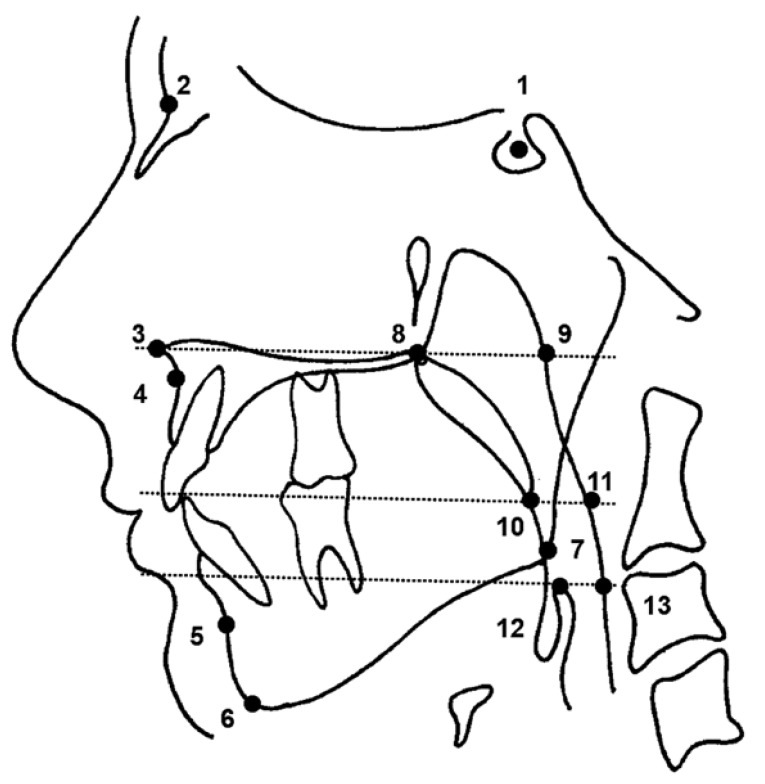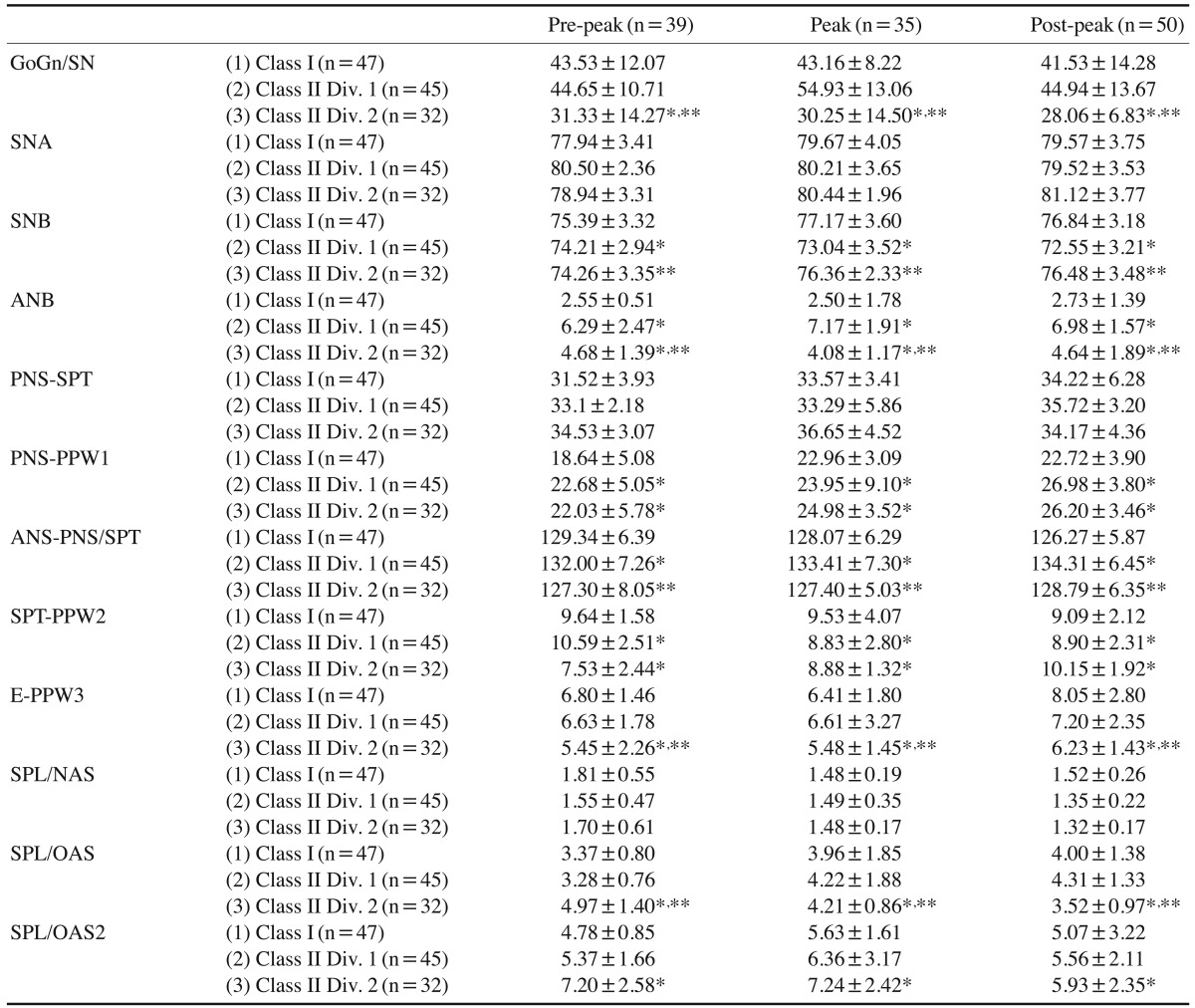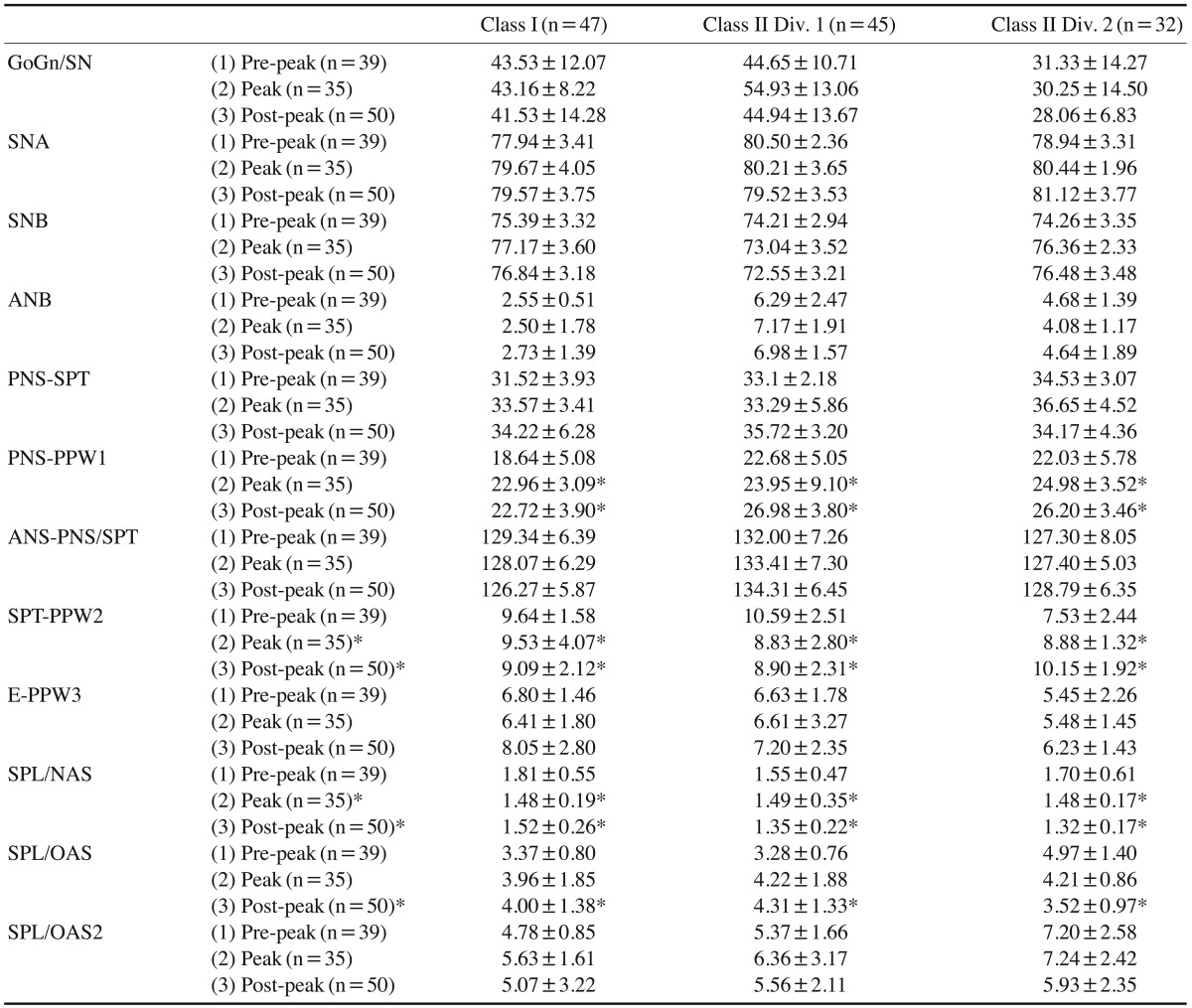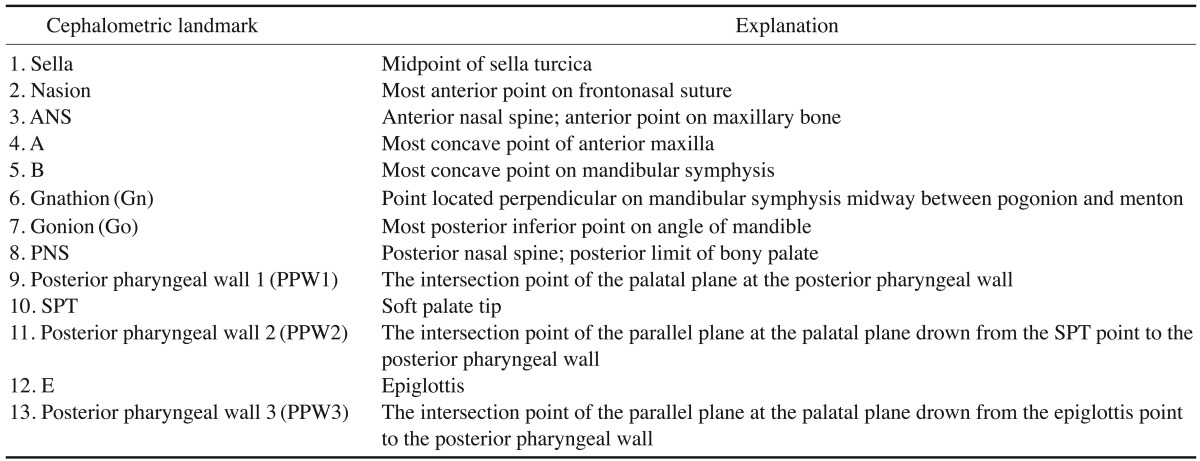1. McNamara JA. Influence of respiratory pattern on craniofacial growth. Angle Orthod. 1981; 51:269–300. PMID:
6947703.

2. Han S, Choi YJ, Chung CJ, Kim JY, Kim KH. Long-term pharyngeal airway changes after bionator treatment in adolescents with skeletal Class II malocclusions. Korean J Orthod. 2014; 44:13–19. PMID:
24511511.

3. Soni J, Shyagali TR, Bhayya DP, Shah R. Evaluation of pharyngeal space in different combinations of Class II skeletal malocclusion. Acta Inform Med. 2015; 23:285–289. PMID:
26635436.

4. Zinsly SR, Moraes LC, Moura P, Ursi W. Assessment of pharyngeal airway space using cone-beam computed tomograpy. Dental Press J Orthod. 2010; 15:150–158.
5. Martin SE, Mathur R, Marshall I, Douglas NJ. The effect of age, sex, obesity and posture on upper airway size. Eur Respir J. 1997; 10:2087–2090. PMID:
9311508.

6. Tourné LP. Growth of the pharynx and its physiologic implications. Am J Orthod Dentofacial Orthop. 1991; 99:129–139. PMID:
1990822.

7. Johnston CD, Richardson A. Cephalometric changes in adult pharyngeal morphology. Eur J Orthod. 1999; 21:357–362. PMID:
10502898.

8. Martin O, Muelas L, Vinas MJ. Nasopharyngeal cephalometric study of ideal occlusions. Am J Orthod Dentofacial Orthop. 2006; 130:436.e1–436.e9. PMID:
17045141.

9. Späth-Schwalbe E, Hundenborn C, Kern W, Fehm HL, Born J. Nocturnal wakefulness inhibits growth hormone (GH)-releasing hormone-induced GH secretion. J Clin Endocrinol Metab. 1995; 80:214–219. PMID:
7829614.

10. Born J, Muth S, Fehm HL. The significance of sleep onset and slow wave sleep for nocturnal release of growth hormone (GH) and cortisol. Psychoneuroendocrinology. 1988; 13:233–243. PMID:
3406323.

11. Bollhalder J, Hanggi MP, Schatzle M, Markic G. Dentofacial and upper airway characteristics of mild and severe class II division 1 subjects. Eur J Orthod. 2013; 35:447–453. PMID:
22427406.

12. Battagel JM, Johal A, Kotecha B. A cephalometric comparison of subjects with snoring and obstructive sleep apnoea. Eur J Orthod. 2000; 22:353–365. PMID:
11029825.

13. Lowe AA, Fleetham JA, Adachi S, Ryan CF. Cephalometric and computed tomographic predictors of obstructive sleep apnoea severity. Am J Orthod Dentofacial Orthop. 1995; 107:589–595. PMID:
7771363.
14. Yavuz B, Kocadereli İ. Sınıf II malokluzyonlarda uygulanan tedavi yaklaşımlarının üst hava yolu üzerine etkileri. EÜ Dişhek Fak Derg. 2013; 34:66–72.
15. Coben SE. The biology of Class II treatment. Am J Orthod. 1971; 59:470–487. PMID:
5279861.

16. Souki BQ, Pimenta GB, Souki MQ, Franco LP, Becker HM, Pinto JA. Prevalence of malocclusion among mouth breathing children: do expectations meet reality? Int J Pediatr Otorhinolaryngol. 2009; 73:767–773. PMID:
19282036.

17. Agren K, Nordlander B, Linder-Aronsson S, Zettergren-Wijk L, Svanborg E. Children with nocturnal upper airway obstruction: postoperative orthodontic and respiratory improvement. Acta Otolaryngol. 1998; 118:581–587. PMID:
9726687.
18. Kim YJ, Hong JS, Hwang YI, Park YH. Three-dimensional analysis of pharyngeal airway in preadolescent children with different anteroposterior skeletal patterns. Am J Orthod Dentofacial Orthop. 2010; 137:306.e1–306.e11. PMID:
20197163.

19. Güngör OE, Celikoğlu M, Kale B, Güngör AY, Sarı Z. The reliability of the Greulich and Pyle atlas when applied to a Southern Turkish population. Eur J Dent. 2015; 9:251–254. PMID:
26038659.

20. Jakhi SA, Karjodkar FR. Use of cephalometry in diagnosing resonance disorders. Am J Orthod Dentofacial Orthop. 1990; 98:323–332. PMID:
2220693.

21. Wu JT, Huang GF, Huang CS, Noordhoff MS. Nasopharyngoscopic evaluation and cephalometric analysis of velopharynx in normal and cleft palate patients. Ann Plast Surg. 1996; 36:117–123. PMID:
8919372.

22. Aboudara C, Nielsen I, Huang JC, Maki K, Miller AJ, Hatcher D. Comparison of airway space with conventional lateral headfilms and 3-dimensional reconstruction from cone-beam computed tomography. Am J Orthod Dentofacial Orthop. 2009; 135:468–479. PMID:
19361733.

23. El H, Palomo JM. Airway volume for different dentofacial skeletal patterns. Am J Orthod Dentofacial Orthop. 2011; 139:e511–e521. PMID:
21640863.

24. Hellsing E. Changes in pharyngeal airway in relation to extension of the head. Eur J Orthod. 1989; 11:359–365. PMID:
2591483.
25. Pracharktam N, Hans MG, Strohl KP, Redline S. Upright and supine cephalometric evaluation of obstructive sleep apnoea syndrome an snoring subjects. Angle Orthod. 1994; 64:63–73. PMID:
8172396.
26. Handelman CS, Osborne G. Growth of the nasopharynx and adenoid development from one to eighteeen years. Angle Orthod. 1976; 46:243–259. PMID:
1066976.
27. Jeans WD, Fernando DC, Maw AR, Leighton BC. A longitudinal study of the growth of the nasopharynx and its contents in normal children. Br J Radiol. 1981; 54:117–121. PMID:
7459548.

28. Subtelny JD. Malocclusions, orthodontic corrections and orofacial muscle adaptation. Angle Orthod. 1970; 40:170–201. PMID:
5269951.
29. Ceylan I, Oktay H. A study on the pharyngeal size in different skeletal patterns. Am J Orthod Dentofacial Orthop. 1995; 108:69–75. PMID:
7598107.

30. Zhong Z, Tang Z, Gao X, Zeng XL. A comparison study of upper airway among different skeletal craniofacial patterns in nonsnoring Chinese children. Angle Orthod. 2010; 80:267–274. PMID:
19905851.

31. Sosa FA, Graber TM, Muller TP. Postpharyngeal lymphoid tissue in Angle Class I and Class II malocclusions. Am J Orthod. 1982; 81:299–309. PMID:
6960717.

32. Wenzel A, Williams S, Ritzau M. Relationships of changes in craniofacial morphology, head posture, and nasopharyngeal airway size following mandibular osteotomy. Am J Orthod Dentofacial Orthop. 1989; 96:138–143. PMID:
2756949.

33. de Freitas MR, Alcazar NM, Janson G, de Freitas KM, Henriques JF. Upper and lower pharyngeal airways in subjects with Class I and Class II malocclusions and different growth patterns. Am J Orthod Dentofacial Orthop. 2006; 130:742–745. PMID:
17169736.

34. Alves PV, Zhao L, O'Gara M, Patel PK, Bolognese A. Three-dimensional cephalometric study of upper airway space in skeletal class II and III healthy patients. J Craniofac Surg. 2008; 19:1497–1507. PMID:
19098539.

35. Memon S, Fida M, Shaikh A. Comparison of different craniofacial patterns with pharyngeal widths. J Coll Physicians Surg Pak. 2012; 22:302–306. PMID:
22538035.
36. Kerr WJ. The nasopharynx, face height and overbite. Angle Orthod. 1985; 55:31–36. PMID:
3856405.
37. Keçik D. The effect of mandibular position on upper airway dimensions. Turk J Orthod. 2009; 22:93–101.
38. Grauer D, Cevidanes LS, Styner MA, Ackerman JL, Proffit WR. Pharyngeal airway volume and shape from cone-beam computed tomography: relationship to facial morphology. Am J Orthod Dentofacial Orthop. 2009; 136:805–814. PMID:
19962603.

39. Ozbek MM, Memikoglu TU, Gögen H, Lowe AA, Baspinar E. Oropharyngeal airway dimensions and functional-orthopedic treatment in skeletal Class II cases. Angle Orthod. 1998; 68:327–336. PMID:
9709833.









 PDF
PDF ePub
ePub Citation
Citation Print
Print




 XML Download
XML Download